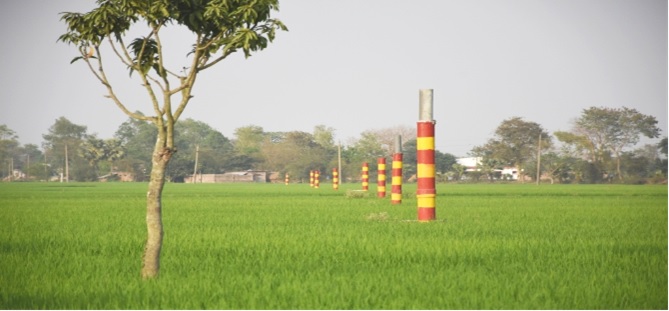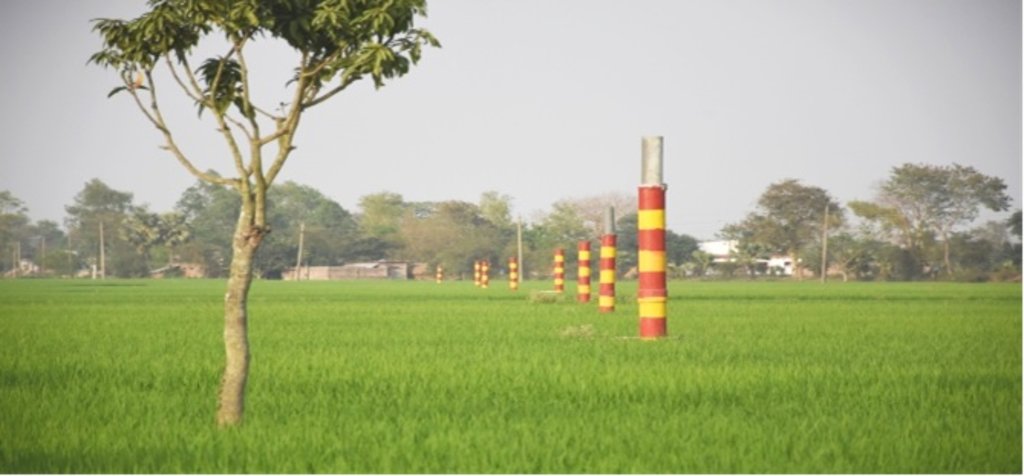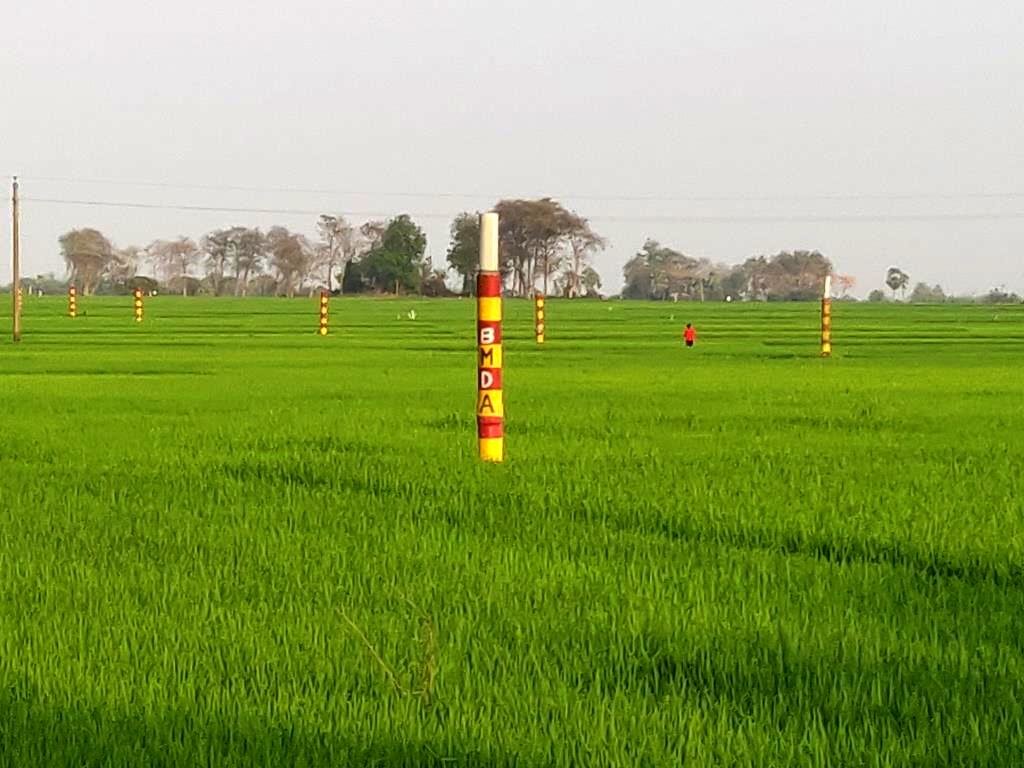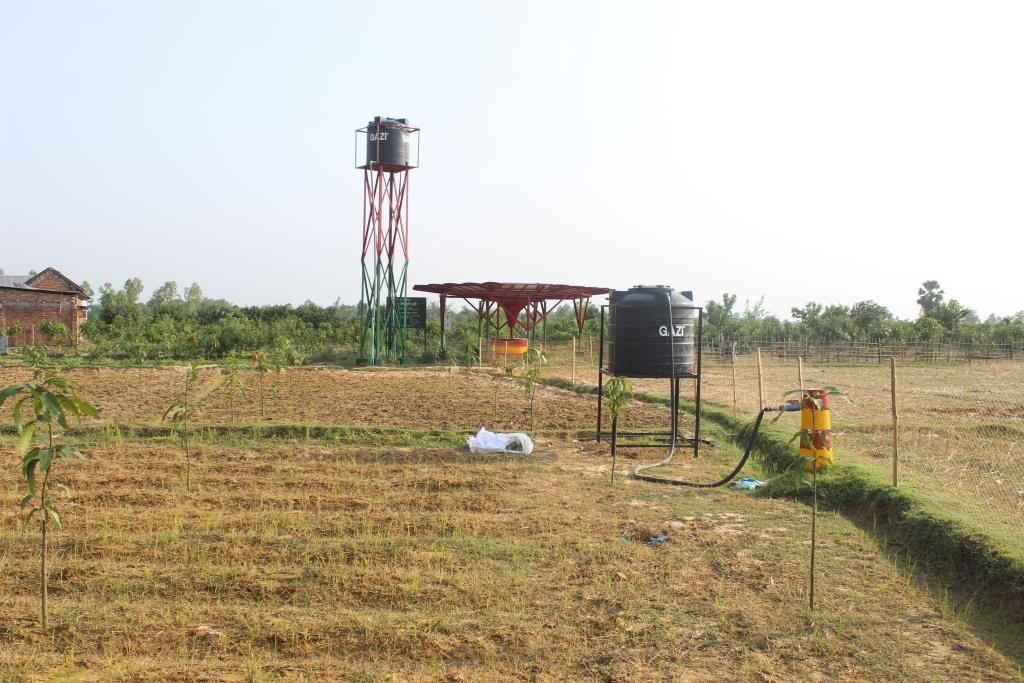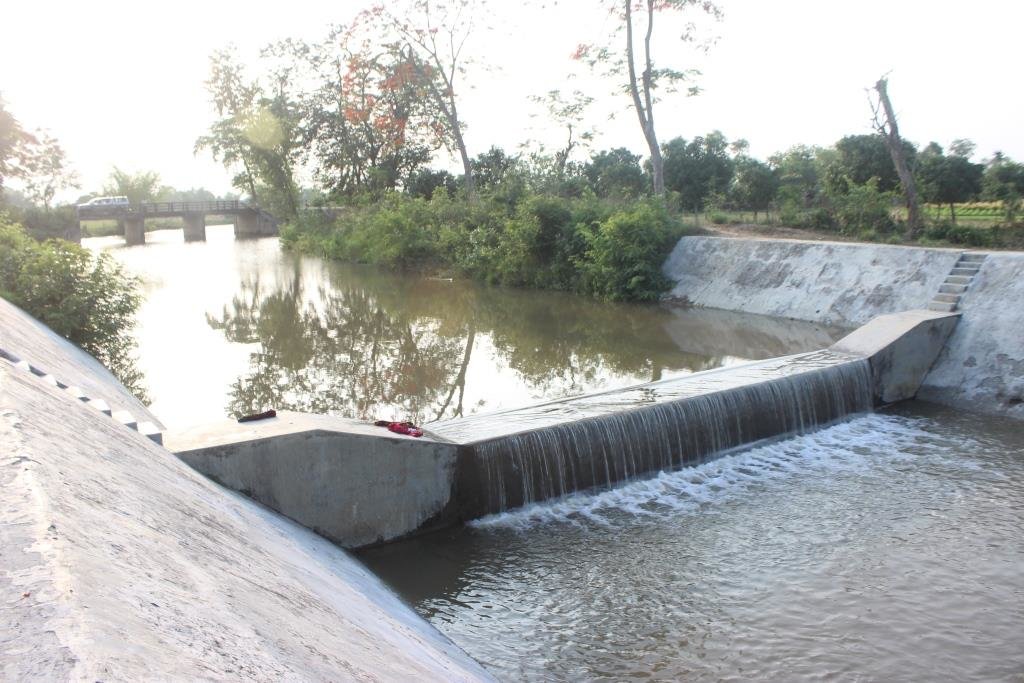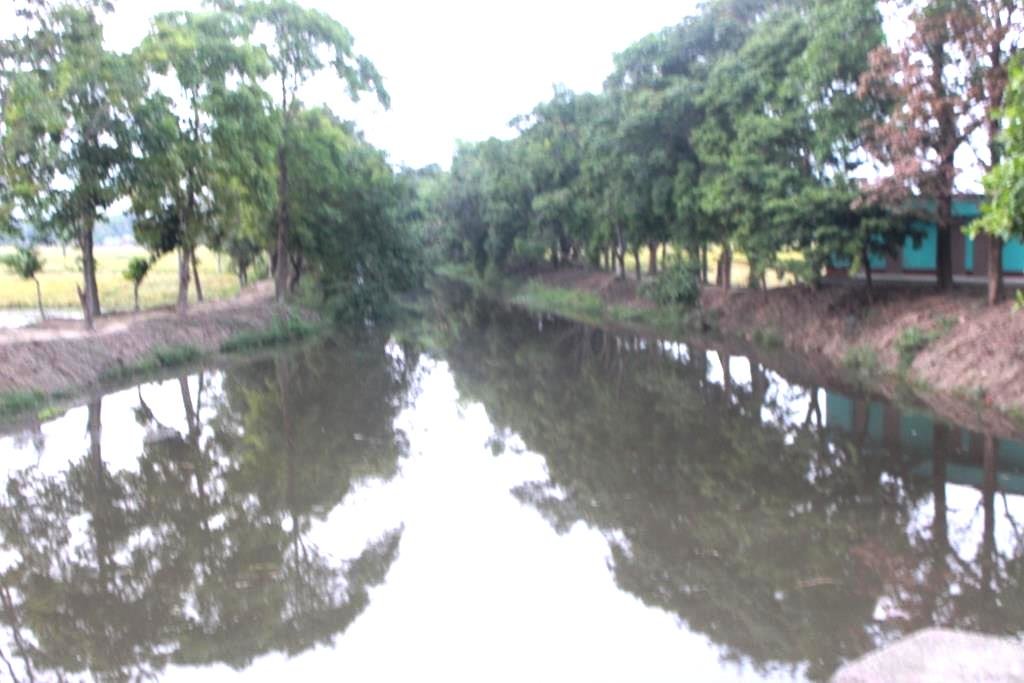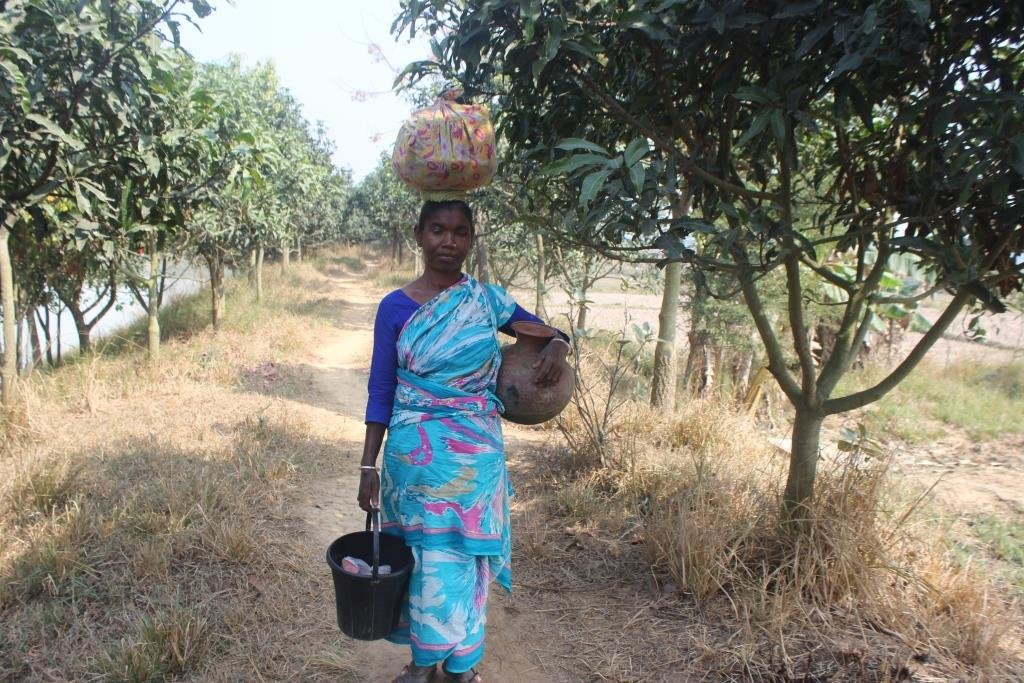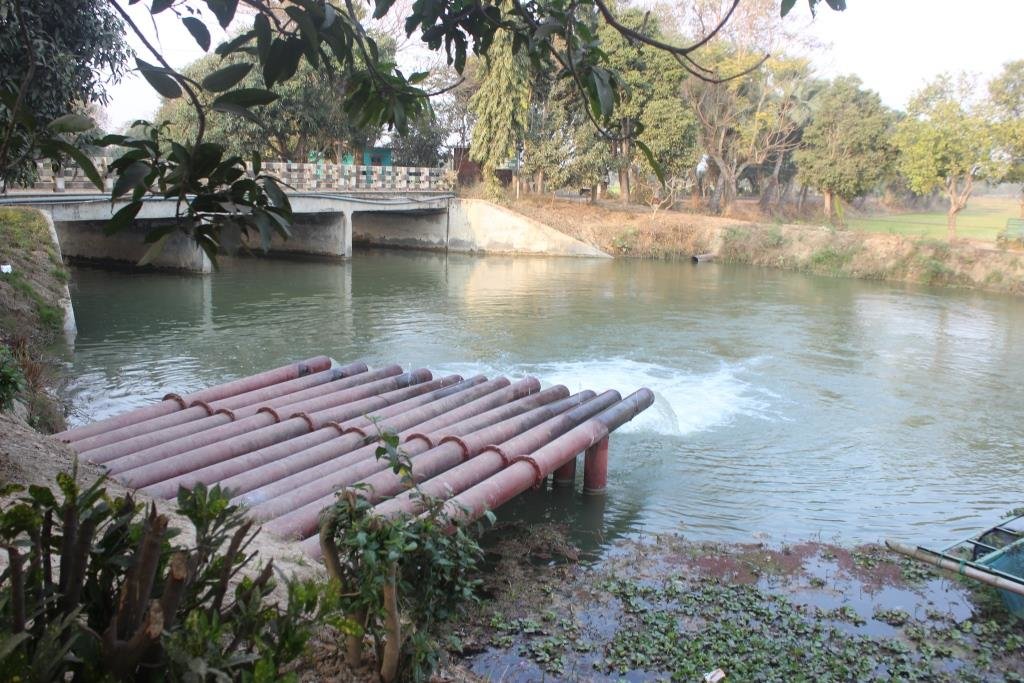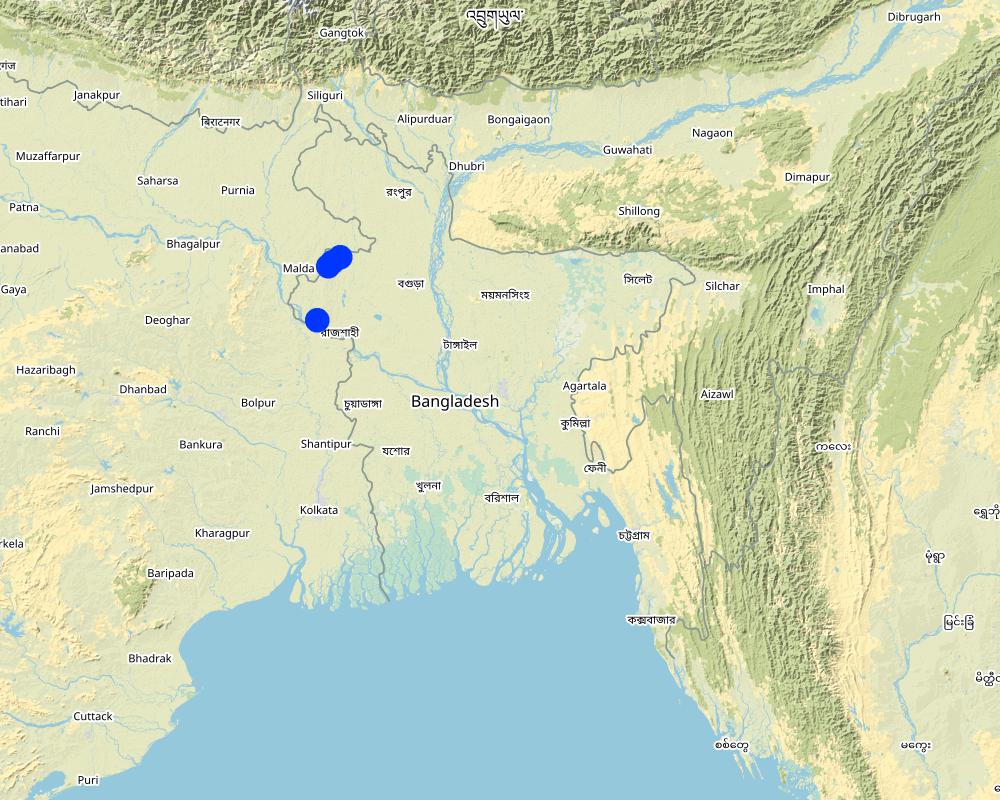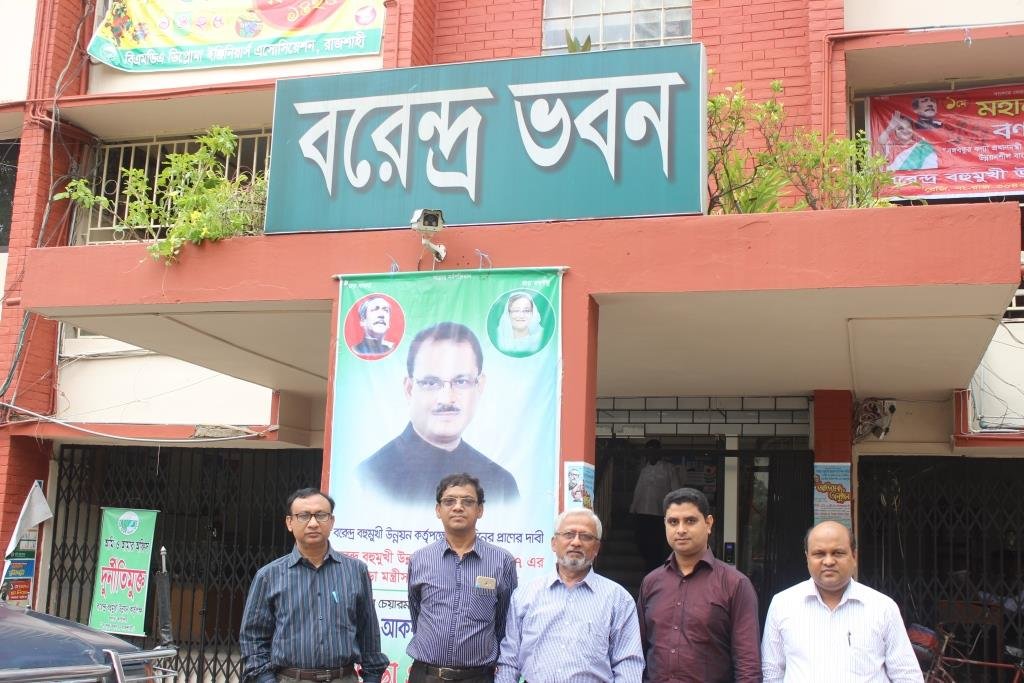Halting seasonal drought in Barind through efficient water resource management [بنغلاديش]
- تاريخ الإنشاء:
- تحديث:
- جامع المعلومات: Jalal Uddin Md. Shoaib
- المحرر: –
- المراجعون: William Critchley, Rima Mekdaschi Studer
Barendra elakay Khara proshaman
approaches_6143 - بنغلاديش
عرض الأقسام
توسيع الكل طي الكل1. معلومات عامة
1.2 تفاصيل الاتصال بالأشخاص الرئيسيين لمصدر المعلومات والمؤسسات المعنية بتقييم وتوثيق النهج
اسم المشروع الذي سهّل توثيق/تقييم النهج (إذا كان ذلك على صلة)
Establishing National Land Use and Land Degradation Profile toward Mainstreaming SLM Practices in Sector Policies (ENALULDEP/SLM)اسم المؤسسة (المؤسسات) التي سهلت توثيق/تقييم النهج (إذا كان ذلك على صلة)
Department of Environment (DoE) - بنغلاديش1.3 الشروط المتعلقة باستخدام البيانات الموثقة من خلال WOCAT
متى تم تجميع البيانات (ميدانيا)؟:
08/04/2020
يوافق جامع المعلومات والشخص (لاشخاص) الرئيسي لمصدر المعلومات على الشروط المتعلقة باستخدام البيانات الموثقة من خلال WOCAT:
نعم
2. وصف نهج الإدارة المستدامة للأراضي
2.1 وصف موجز للنهج
Introduction of sustainable water usage to prevent impacts of seasonal droughts in Barind region, Bangladesh
2.2 وصف تفصيلي للنهج
وصف تفصيلي للنهج:
Barind is a drought-affected area of Bangladesh. It covers about 7,770 sq. km, that is 41% of the North Western part of Bangladesh, spreading over 16 districts of Rajshahi and Rangpur Division. It is one of the driest areas in Bangladesh with comparatively high temperatures - though cooler in the wet season from mid-June to October. Rainfall in the area varies from about 1500 mm to 2000 mm per annum. Temperature ranges from 4 degree Celsius to 44 degree Celsius. The area is at a comparatively higher elevation than the adjoining floodplains. There are two main terrace levels - one at 40m and the other between 19.8 and 22.9 m above mean sea level. The total cultivable area of Barind is about 583,000 ha, of which 34% is loamy, 10% is sandy, and 49% is clay: the remaining 7% is of other composition.
In the 1980s, the area was predominantly single cropped, and yields were poor and subject to seasonal drought, from late February to early May (up to the onset of pre-monsoon). No crops could be grown during the "rabi" season (November to May). The impacts of drought were severe and affected food insecurity and livelihoods. To address the situation, the Bangladesh Agricultural Development Corporation (BADC) under the Ministry of Agriculture (MoA) initiated two projects. One in 1985: The Barind Integrated Area Development Project and subsequently in 1992, the Barind Multipurpose Development Authority (BMDA) as a separate institutional entity. Both the projects focused on a new approach to water extraction, distribution and management practices at institutional level. Deep tubewells were installed and maintained by BMDA, rather than privately (which is often practiced in other parts of the country).
Deep tubewells (DTWs) were installed to abstract water from 15-20 meters, and water was initially distributed through open channels. Later, these were fitted with smart card–operated electric/solar pumps to develop a drought-resilient irrigation system Both projects have helped the Barind region reduce poverty and achieve self-sufficiency in rice. Without supplementary irrigation, there would be crop failure.
Since it was established, BMDA has focused on halting seasonal drought in Barind, and increased cropping intensity by providing irrigation through 15,800 DTWs in different districts. That reduced the cost of irrigation water for one bigha (0.1ha) from about $40 to <$20. On the other hand initiation of smart cards and buried pipelines for water distribution increased the efficiency of water use and facilitated revenue collection by the BMDA. However abstraction of groundwater (GW) for irrigation triggered another issue - drawdown of GW in the area, which even led to abandoning shallow tubewells (STW) used for drinking water.
In 2004 BMDA initiated another project, to lift surface water from the Padma river to ponds/canals/rivers in the main land after re-excavation. These sources are used as reservoirs and at the same time contribute to GW recharge generally. At the same time, usage of solar power instead of electricity is another means of reducing the cost of pumping water.
BMDA again installed 490 dugwells where STW or DTW could not be constructed. These dug wells are used for safe drinking water and small-scale irrigation. These measures have meant that, at present, the area avoids seasonal drought in most of the locations. Potatoes, "boro" and transplanted "aman" occupy more than 50% of the cultivable land. In addition, provision of safe drinking water and improved communications have boosted the local economy. The approach embraces various technologies including (1) tapping river water (from the Ganges, Mahananda and Tangan rivers0; (2) storing water in creeks or ponds; (3) distribution to farm land through subsurface irrigation pipes (buried pipelines); (4) use of low lift pumps (LLP) with solar energy support ; (5) prepaid water metering - usage of smart cards; (6) conversion of derelict water bodies to become effective water reservoirs ; (7) dug wells with solar power for water abstraction; (8) orchard plantations where both surface or groundwater are limited; (9) plantations of trees and horticultural crops along road and channels to change the land cover; (10) usage of compost to improve soil health. All of these contribute to land degradation neutrality (LDN) in one way or another.
Finally BMDA's approach is to boost productivity in the drought affected Barind through its projects, and encouraged communities to adopt diversified land use: previously much land remained fallow during most of the year outside the monsoon. Institutions like Department of Agricultural Extension (DAE) and many NGOs promote a variety of seasonal, annual and perennial crops in the area, the use of balanced fertilizer, plantation of high density fruit crops. The impact of the BMDA approach has greatly changed the drought-affected Barind.
2.3 صور عن النهج
ملاحظات عامة بخصوص الصور:
All these pictures demonstrate the usage of surface water for irrigation and livelihoods in Barind.
2.5 البلد/المنطقة/المواقع التي تم تطبيق النهج فيها
البلد:
بنغلاديش
المنطقة/الولاية/المحافظة:
Rajshahi
التعليقات:
Barind which was the driest area of Bangladesh, has now changed its landscape to green.
Map
×2.6 تواريخ بدء وإنهاء تنفيذ النهج
أشر إلى سنة البدء:
1992
التعليقات:
Barind Multipurpose Development Authority (BMDA) is continuing with more development projects to provide irrigation facilities with more options. Cropping intensity has increased, and most of the single cropped land has been transformed to double and triple cropped land.
2.7 نوع النهج
- قائم على مشروع/برنامج
2.8 الغايات/الأهداف الرئيسية للنهج
To provide irrigation water for cropping in dry season.
To increase cropping intensity in drought affected areas of Barind.
To manage land use or land cover in Barind.
To mobilize community on rational usage of soil and water resources.
2.9 الظروف التي تمكن أو تعيق تنفيذ التقنية/التقنيات المطبقة بموجب النهج
المعايير والقيم الاجتماعية /الثقافية/ الدينية
- تمكين/تمكيني
Increased livelihood options and access to education, marketing, health services.
توفر/الوصول إلى الموارد والخدمات المالية
- تمكين/تمكيني
Increased access to financial institution.
الإطار المؤسساتي
- تمكين/تمكيني
All technical support provided by BMDA.
التعاون/التنسيق بين الجهات الفاعلة
- تمكين/تمكيني
BMDA supports all action in related to irrigation, maintenance, water supply etc.
الإطار القانوني (حيازة الأراضي، وحقوق استخدام الأراضي والمياه)
- تمكين/تمكيني
Lands owned by land users
السياسات
- تمكين/تمكيني
Land users are in the line of BMDA policies.
حوكمة الأراضي (صنع القرار والتنفيذ والإنفاذ)
- تمكين/تمكيني
Traditional approach.
المعرفة حول الإدارة المستدامة للأراضي، والوصول إلى الدعم الفني
- تمكين/تمكيني
Community has access to technical support.
الأسواق (لشراء المدخلات وبيع المنتجات) والأسعار
- تمكين/تمكيني
All inputs are available in the area.
عبء العمل، توفر القوى العاملة
- تمكين/تمكيني
Available, people are getting work now.
3. المشاركة وأدوار الأطراف المعنية
3.1 أصحاب المصلحة المعنيون بالنهج وأدوارهم
- مستخدمو الأراضي المحليون/المجتمعات المحلية
Men and women are involved in the process
Growing crops as of their choice, for example: rice, fruits, vegetables or orchard trees.
- المنظمات المجتمعية
Farmers have societies,
Influenced in choice of crops, etc.
- منظمة غير حكومية
Several NGO s are functional in the area.
Most of them are supporting credit and marketing facilities
- الحكومة المحلية
Local institutions involved in the process
Capacity building, advisory services on fertilizer usage, crop selection etc.
إذا كان هناك العديد من الأطراف المعنية، قم بالإشارة إلى الوكالة الرائدة:
BMDA is working as lead agency
3.2 انخراط مستخدمي الأراضي المحليين/المجتمعات المحلية في المراحل المختلفة للنهج
| انخراط مستخدمي الأراضي المحليين/المجتمعات المحلية | حدد من شارك وصف الأنشطة | |
|---|---|---|
| المبادرة/التحفيز | سلبي | Farmers are using irrigation water for their crops supplied by BMDA and they pay revenue |
| التخطيط | سلبي | Farmer nor the community are involved in the planning process |
| التنفيذ | سلبي | Land users allow to set buried pipelines under their fields. |
| الرصد/التقييم | سلبي | Land users are not involved in the M&E but they participate in the events organized. |
| غير موجود | Land users only choose their crops to be grown |
3.3 مخطط التدفق (إذا كان متاحًا)
الوصف:
Barind Multipurpose Development Authoroty (BMDA) is the symbol of development in Barind area also of the Tista fldooplain and the Old Himalayan piedmont plain.
المؤلف:
ShoaibJU
3.4 اتخاذ القرار بشأن اختيار تقنية/تقنيات الإدارة المستدامة للأراضي
حدد من الذي قرر اختيار التقنية/التقنيات التي سيتم تنفيذها:
- مستخدمو الأراضي بشكل أساسي، بدعم من متخصصي الإدارة المستدامة للأراضي
حدد على أي أساس تم اتخاذ القرارات:
- تقييم المعرفة الموثقة جيدًا بشأن الإدارة المستدامة للأراضي(اتخاذ القرارات القائمة على الأدلة)
- نتائج البحوث
- خبرة وآراء شخصية(غير موثقة)
4. الدعم الفني وبناء القدرات وإدارة المعرفة
4.1 بناء القدرات/التدريب
هل تم تقديم التدريب لمستخدمي الأراضي / الأطراف المعنيين الآخرين؟:
نعم
حدد من تم تدريبه:
- مستخدمو الأراضي
- موظفون ميدانيون/ مستشارون
إذا كان ذلك على صلة، حدد الجنس والعمر والوضع والعرق وما إلى ذلك.
BMDA has trained staff to care for the system by and large. There are both male and female staff.
شكل التدريب:
- في العمل
- مناطق العرض
المواضيع المغطاة:
Buried pipeline maitenance, good seed production, marketing etc.
4.2 خدمة استشارية
هل يملك مستخدمو الأراضي وصولا إلى خدمة استشارية؟:
نعم
حدد ما إذا كانت الخدمة الاستشارية متوفرة:
- في مراكز دائمة
وصف/تعليقات:
BMDA has field offices at each upazila to look after the system
4.3 تعزيز المؤسسات (التطوير التنظيمي)
هل تم إنشاء أو تعزيز مؤسسات من خلال هذا النهج؟:
- نعم، إلى حد كبير
حدد المستوى (المستويات) التي تم فيها تعزيز أو إنشاء المؤسسات:
- محلي
- إقليمي
صف المؤسسة والأدوار والمسؤوليات والأعضاء وما إلى ذلك.
BMDA has it headquarters at Rajshai city and sub-offices at all "upazila" to where the pipeline extended.
حدد نوع الدعم:
- بناء القدرات/التدريب
- معدات
4.4 الرصد والتقييم
هل يشكل الرصد والتقييم جزءا من النهج؟:
نعم
التعليقات:
BMDA monitors groundwater levels regularly, and also the pipelines and other operational activities.
إذا كانت الإجابة بنعم، فهل من المقصود استخدام هذه الوثائق للمراقبة والتقييم؟:
نعم
التعليقات:
During the documentation of the SLM best practices of the Banrind area intensive conversations, meetings and workshops were organized with all officials of headquarter and filed offices.
4.5 البحوث
هل كانت البحوث جزءًا من النهج؟:
كلا
5. التمويل والدعم المادي الخارجي
5.1 الميزانية السنوية لمكون الإدارة المستدامة للأراضي في النهج المذكور
إذا لم تكن الميزانية السنوية الدقيقة معروفة، قم بالإشارة إلى نطاقها:
- 100,000-10,000
5.2 الدعم المالي/المادي المقدم لمستخدمي الأراضي
هل حصل مستخدمو الأراضي على دعم مالي/ مادي لتنفيذ التقنية/ التقنيات؟:
نعم
إذا كانت الإجابة بنعم، حدد نوع (أنواع) الدعم والشروط والمزودين:
All infrastructural establishment cost were born by BMDA
5.3 إعانات لمدخلات محددة (بما في ذلك العمالة)
- غير موجود
- معدات
| حدد المدخلات التي تم دعمها | إلى أي مدى | حدد الإعانات |
|---|---|---|
| حجر | ممول بالكامل | |
- بناء
| حدد المدخلات التي تم دعمها | إلى أي مدى | حدد الإعانات |
|---|---|---|
| طرق | ممول بالكامل | |
- بنى تحتية
| حدد المدخلات التي تم دعمها | إلى أي مدى | حدد الإعانات |
|---|
5.4 الائتمان
هل تم توفير ائتمان في إطار نهج أنشطة الإدارة المستدامة للأراضي؟:
كلا
5.5 حوافز أو وسائل أخرى
هل تم استخدام حوافز أو أدوات أخرى لتشجيع تنفيذ تقنيات الإدارة المستدامة للأراضي؟:
نعم
إذا كانت الإجابة بنعم، حدد:
Installation and maintenance cost borne by BMDA, but farmers have to pay for water through smart cards (Pre-paid).
6. تحليل الأثر والتصريحات الختامية
6.1 آثار النهج
هل ساهم النهج في تمكين مستخدمي الأراضي المحليين وتحسين مشاركة الأطراف المعنية؟:
- لا
- نعم، قليلا
- نعم، باعتدال
- نعم، إلى حد كبير
Farmers are using irrigation water for their crops
هل مكّن النهج من اتخاذ القرارات المبنية على الأدلة؟:
- لا
- نعم، قليلا
- نعم، باعتدال
- نعم، إلى حد كبير
As of now buried pipe lines for irrigation water supply are being adopting in many areas of the country.
هل ساعد النهج مستخدمي الأراضي على تنفيذ وصيانة تقنيات الإدارة المستدامة للأراضي؟:
- لا
- نعم، قليلا
- نعم، باعتدال
- نعم، إلى حد كبير
Usage of water rationally: BMDA installs control meters for each of the land user.
هل نجح النهج في تحسين التنسيق والتنفيذ الفعال من حيث التكلفة لأنشطة الإدارة المستدامة للأراضي؟:
- لا
- نعم، قليلا
- نعم، باعتدال
- نعم، إلى حد كبير
The approach had changed the Barind ecosystem at large.
هل أدى النهج إلى تحسين معرفة وقدرات مستخدمي الأراضي على تنفيذ الإدارة المستدامة للأراضي؟:
- لا
- نعم، قليلا
- نعم، باعتدال
- نعم، إلى حد كبير
Land users enable to use irrigation water for growing crops of their choice
هل أدى النهج إلى تحسين معرفة وقدرات الأطراف المعنية الأخرى؟:
- لا
- نعم، قليلا
- نعم، باعتدال
- نعم، إلى حد كبير
Other local institutions in Barind area are involved in the system.
هل ساهم النهج في بناء/تعزيز المؤسسات والتعاون بين الأطراف المعنية؟:
- لا
- نعم، قليلا
- نعم، باعتدال
- نعم، إلى حد كبير
Adoption of the irrigation system at all areas of the Barind.
هل ساهم النهج في التخفيف من حدة الصراعات؟:
- لا
- نعم، قليلا
- نعم، باعتدال
- نعم، إلى حد كبير
Stakeholders are enable to use water as they like.
هل ساهم النهج في تمكين الفئات المحرومة اجتماعيا واقتصاديا؟:
- لا
- نعم، قليلا
- نعم، باعتدال
- نعم، إلى حد كبير
The area was resource poor before the 1990s. Now livelihoods of the community improved largely.
هل أدى النهج إلى تحسين المساواة بين الجنسين وتمكين النساء والفتيات؟:
- لا
- نعم، قليلا
- نعم، باعتدال
- نعم، إلى حد كبير
Man and women are engaged themselves in their land and crops.
هل شجع النهج الشباب/الجيل القادم من مستخدمي الأراضي على الانخراط في الإدارة المستدامة للأراضي؟:
- لا
- نعم، قليلا
- نعم، باعتدال
- نعم، إلى حد كبير
Interventions with new crops, specially high value fruits etc in the area.
هل أدى النهج إلى تحسن في مسائل حيازة الأراضي / حقوق المستخدمين التي أعاقت تنفيذ تقنيات الإدارة المستدامة للأراضي؟:
- لا
- نعم، قليلا
- نعم، باعتدال
- نعم، إلى حد كبير
Land tenure system is traditional, where large areas are sublet or leased to the individuals or groups by the land owners.
هل أدى هذا النهج إلى تحسين الأمن الغذائي / تحسين التغذية؟:
- لا
- نعم، قليلا
- نعم، باعتدال
- نعم، إلى حد كبير
The area produces a large amount of cereals, potatoes, vegetables, fruits etc.
هل أدى النهج إلى تحسين الوصول إلى الأسواق؟:
- لا
- نعم، قليلا
- نعم، باعتدال
- نعم، إلى حد كبير
Fruits and paddy rice have good markets.
هل أدى النهج إلى تحسين الوصول إلى المياه والصرف الصحي؟:
- لا
- نعم، قليلا
- نعم، باعتدال
- نعم، إلى حد كبير
Safe drinking water where tubewells do not function, and sanitation also developed as the system.
هل أدى النهج إلى استخدام طاقة/ مصادر طاقة أكثر استدامة؟:
- لا
- نعم، قليلا
- نعم، باعتدال
- نعم، إلى حد كبير
Using solar power to abstract dug well water greatly facilitates the community.
هل أدى النهج إلى تحسين قدرة مستخدمي الأراضي على التكيف مع التغيرات المناخية/الظواهر المناخية المتطرفة والتخفيف من الكوارث المرتبطة بالمناخ؟:
- لا
- نعم، قليلا
- نعم، باعتدال
- نعم، إلى حد كبير
Vegetative cover in the Barind has changed the ecosystem at large.
هل أدى النهج إلى توفير فرص عمل ودخل؟:
- لا
- نعم، قليلا
- نعم، باعتدال
- نعم، إلى حد كبير
Local people are having work everywhere of the Barind.
6.2 المحفز الرئيسي لقيام مستخدمي الأراضي بتنفيذ الإدارة المستدامة للأراضي
- زيادة الإنتاج
Cropping intensity increased
- زيادة الربح (القدرة)، وتحسين نسبة التكلفة إلى العائد
Low cost of irrigation water contributes to benefits for the land users.
- الحد من تدهور الأراضي
Halts or reduces seasonal drought
- الحد من مخاطر الكوارث
Less climate extremes, no crop loss due to drought. Temperature relatively cooler than before.
- القواعد واللوائح (الغرامات) / الإنفاذ
No social unrest
- الوجاهة والضغط الاجتماعي/التماسك الاجتماعي
Livehood improved greatly.
- الوعي البيئي
Local people are now aware of the environment. They grow trees around their homesteads, preserve water in their ponds etc.
6.3 استدامة أنشطة النهج
هل يمكن لمستخدمي الأراضي المحافظة على استدامة ما تم تنفيذه من خلال النهج (بدون دعم خارجي)؟:
- نعم
إذا كانت الإجابة بنعم، صف كيف:
Buried pipeline irrigation has changed the Barind area greatly.
6.4 نقاط قوة/مزايا النهج
| نقاط القوة/ المزايا/ الفرص من وجهة نظر مستخدمي الأراضي |
|---|
| More crops could be grown throughout the year, |
| Crop diversity is possible, annual, perenial or seasonal |
| Secure crop production |
| نقاط القوة/ المزايا/ الفرص من وجهة نظر جامع المعلومات أو غيره من الاشخاص الرئيسيين لمصدر المعلومات |
|---|
| Minimum loss of irrigation water |
| Surface (river) water usage minimize stress on ground water usage |
| Improved ground water recharge |
| Safe drinking water where tubewell is not available. |
| Usage of solar power for lifting water from dug well or for lifting water to buried pipeline |
| Introduction of water meters reduces misuse of irrigation water |
6.5 نقاط الضعف/ العيوب في المنهج وطرق التغلب عليها
| نقاط الضعف/ المساوىء/ المخاطر من وجهة نظر مستخدم الأراضي | كيف يمكن التغلب عليها؟ |
|---|---|
| The system could be implemented at single farmer level | Developing community approach with the support of the government |
| نقاط الضعف/ المساوىء/ المخاطر من وجهة نظر جامع المعلومات أو غيره من الاشخاص الرئيسيين لمصدر المعلومات | كيف يمكن التغلب عليها؟ |
|---|---|
| Very high pressure on land and soil resources | Lower water consumptive crops could be introduced |
| Severe soil nutrient depletion may develop | Use of manure/ compost or organic matter or crop rotation to enrich soil |
7. المراجع والروابط
7.1 طرق جمع/مصادر المعلومات
- زيارات ميدانية، مسوحات ميدانية
Intensive field visit with responsible officers (5) from BMDA and interview with beneficiaries (30) .
- مقابلات مع مستخدمي الأراضي
Especially the farmers (5) who used to grow very high density fruits crops and of solar powered dugwell (3)
- مقابلات مع المتخصصين/الخبراء في الإدارة المستدامة للأراضي
10 officers from different institutions, like BMDA, DAE, University of Rajshahi, SRDI, NGO, Fishries etc.
- التجميع من التقارير والوثائق الأخرى الموجودة
Few official docments of design and plan of pipelines, dugwell etc.
7.3 روابط للمعلومات ذات الصلة المتوفرة على الإنترنت
العنوان/الوصف:
Baring Multipupose Development Authority
عنوان الرابط URL:
http://www.bmda.gov.bd/site/page/2ea693ba-ac10-4ada-b304-111d72a72105/-#
العنوان/الوصف:
Pro-Poor Groundwater Development
عنوان الرابط URL:
https://openknowledge.worldbank.org/bitstream/handle/10986/33246/Pro-Poor-Groundwater-Development-The-Case-of-the-Barind-Experiment-in-Bangladesh.pdf?sequence=5
الروابط والوحدات المواضيعية
توسيع الكل طي الكلالروابط
لا يوجد روابط
الوحدات المواضيعية
لا يوجد وحدات مواضيعية


